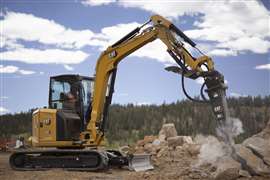Derby demolition double for Safedem
02 July 2013

After almost 20 years of multi storey demolitions, Dundee City Council awarded their last two tower blocks to local company Safedem. Starting in 1995, Safedem has steadily changed the skyline of its home town by demolishing more than 40 tower blocks across the city in this period.
At 27 storeys, the Derby Street blocks were built in an area surrounded by sandstone tenements with ornately carved date stones from the 1800s. However it was a relatively modern structure dating from the 1970s, St Martins Church, that was located between the two blocks that captured the media’s attention.
Derby Street is located in the Hilltown area of the city - aptly named as the sloping site saw the tower blocks built off a heavy duty podium structure that resembled the support legs from the nearby Tay Bridge. The slope was such that at the east end of the structure, the 850 mm (34 inch) thick columns were 9 m tall (29.6 ft) - at the west end they were just 3 m (9.9 ft).
The internal floor plan of the structures was also highly unusual, with maisonette style homes spread over three floors, with the centre of the structure offset from the main living areas. The maisonettes were tall and narrow homes with heavily reinforced concrete walls dividing the rooms every 2.75 m (9 ft). A total of 37 heavily reinforced crosswalls at any one level made this one of the most rigid tower blocks Safedem has ever encountered.
All these walls needed to be drilled so each building had in excess of 5,000 drill holes (a standard tower block is closer to 2,500 holes), with each drill hole housing an individual charge and delay detonator.
When assessing the structures and the nearby buildings that were to remain, it was obvious that each structure required its own unique collapse mechanism. The north block needed to be initiated at the east end and directed to the east towards the nearby main road. The south block needed to come straight down and then rotate away from St Martins, ensuring the debris came to rest away from the church towards a series of 4 storey buildings that also form part of Safedem’s overall demolition project in the area. Due to the proximity of the church a protective screen constructed of scaffold was erected at the gable of the church.
The evacuation of this heavily populated city centre location was carried out by Safedem s Community Liaison Team. Hundreds of residents were temporarily evacuated and catered for in a dedicated rest centre, ensuring the demolition could proceed within the target time window.
On initiation, and in front of thousands of onlookers, the two structures dropped as designed in a safe and controlled manner. On inspection of the church, part of the 14,000 tonnes of rubble from the north block had come to rest against the scaffold protection screen. The screen had ensured there was no structural damage to the church, although there was some minor damage to a fire escape area to the rear of the church building. This minor damage will be repaired in the next day or so.
Safedem Managing Director, William Sinclair commented: "I was disappointed to see the minor damage at the church fire escape area because the standards we set ourselves are so high. However these were Dundee’s tallest structures and of a truly complex and rigid construction, and I am delighted they are safely down having collapsed as designed.”
He continued: “This project required real teamwork from a number of agencies and real thanks must go to not just the hardworking Safedem team, but also to Dundee City Council and Police Scotland who worked with us every step of the way to deliver another safe and successful blowdown in Dundee."



